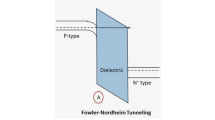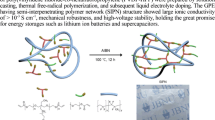Abstract
Organic thin films have been viewed as potential thermoelectric (TE) materials, given their ease of fabrication, flexibility, cost effectiveness, and low thermal conductivity. However, their intrinsically low electrical conductivity is a main drawback which results in a relatively lower TE figure of merit for polymer-based TE materials than for inorganic materials. In this paper, a technique to enhance the ion transport properties of polymers through the introduction of ionic liquids is presented. The polymer is in the form of a nanofiber scaffold produced using the electrospinning technique. These fibers were then soaked in different ionic liquids based on substituted imidazolium such as 1-ethyl-3-methylimidazolium chloride or 1-butyl-3-methylimidazolium bromide. This method was applied to electrospun polyacrylonitrile and a mixture of polyvinyl alcohol and chitosan polymers. The ion transport properties of the membranes have been observed to increase with increasing concentration of ionic liquid, with maximum electrical conductivity of 1.20 × 10−1 S/cm measured at room temperature. Interestingly, the maximum electrical conductivity value surpassed the value of pure ionic liquids. These results indicate that it is possible to significantly improve the electrical conductivity of a polymer membrane through a simple and cost-effective method. This may in turn boost the TE figures of merit of polymer materials, which are well known to be considerably lower than those of inorganic materials. Results in terms of the Seebeck coefficient of the membranes are also presented in this paper to provide an overall representation of the TE potential of the polymer-scaffolded ionic liquid membranes.
Similar content being viewed by others
References
M.F. O’Dwyer, T.E. Humphrey, and H. Linke, Nanotechnology 17, S338 (2006).
B. Yang, H. Ahuja, and T.N. Tran, HVAC Res. 14, 635 (2008).
G.H. Kim, L. Shao, K. Zhang, and K.P. Pipe, Nat. Mater. 12, 719 (2013).
B. Olga, K. Zia Ullah, M. Abdellah, B. Slawomir, F. Mats, B. Magnus, and C. Xavier, Nat. Mater. 10, 429 (2011).
H. Yan, N. Sada, and N. Toshima, J. Therm. Anal. Calorim. 69, 881 (2002).
N. Mateeva, H. Niculescu, J. Schlenoff, and L.R. Testardi, J. Appl. Phys. 83, 3111 (1998).
N.T. Kemp, A.B. Kaiser, C.J. Liu, B. Chapman, O. Mercier, A.M. Carr, H.J. Trodahl, R.G. Buckley, A.C. Partridge, J.Y. Lee, C.Y. Kim, A. Bartl, L. Dunsch, W.T. Smith, and J.S. Shapiro, J. Polym. Sci. B 37, 953 (1999).
S. Masubuchi, S. Kazama, K. Mizoguchi, M. Honda, K. Kume, R. Matsushita, and T. Matsuyama, Synth. Met. 57, 4962 (1993).
J.E. Österholm, P. Passiniemi, H. Isotalo, and H. Stubb, Synth. Met. 18, 213 (1987).
R. Zuzok, A.B. Kaiser, W. Pukacki, and S. Roth, J. Chem. Phys. 95, 1270 (1991).
Y.W. Park, Synth. Met. 45, 173 (1991).
R.D.B. Aïch, N. Blouin, A.I. Bouchard, and M. Leclerc, Chem. Mater. 21, 751 (2009).
I. Lévesque, P.-O. Bertrand, N. Blouin, M. Leclerc, S. Zecchin, G. Zotti, C.I. Ratcliffe, D.D. Klug, X. Gao, F. Gao, and J.S. Tse, Chem. Mater. 19, 2128 (2007).
C. Liu, J. Xu, B. Lu, R. Yue, and F. Kong, J. Electron. Mater. 41, 639 (2012).
D. Papkov, Y. Zou, M.N. Andalib, A. Goponenko, S.Z.D. Cheng, and Y.A. Dzenis, ACS Nano 7, 3324 (2013).
H. Mette and C. Loscoe, Rev. Sci. Instrum. 37, 1537 (1966).
C.-H. Chen, J.C. LaRue, R.D. Nelson, L. Kulinsky, and M.J. Madou, J. Appl. Polym. Sci. 125, 3134 (2012).
S. Ling, W. Jianjun, and B. Elmar, Sci. Rep. 3 (2013). doi:10.1038/srep01991.
I.S. Chronakis, S. Grapenson, and A. Jakob, Polymer 47, 1597 (2006).
P.N.N. Tshibangu, S. Nomathemba, and D. Ezekiel Dixon, Int. J. Electrochem. Sci. 6, 2201 (2011).
S. Chandra, S.S. Sekhon, and N. Arora, Ionics 6, 112 (2000).
T. Stöcker, A. Köhler, and R. Moos, J. Polym. Sci. B 50, 976 (2012).
Author information
Authors and Affiliations
Corresponding author
Rights and permissions
About this article
Cite this article
Datta, R.S., Said, S.M., Sahamir, S.R. et al. Thermoelectric Potential of Polymer-Scaffolded Ionic Liquid Membranes. J. Electron. Mater. 43, 1585–1589 (2014). https://doi.org/10.1007/s11664-013-2799-1
Received:
Accepted:
Published:
Issue Date:
DOI: https://doi.org/10.1007/s11664-013-2799-1




